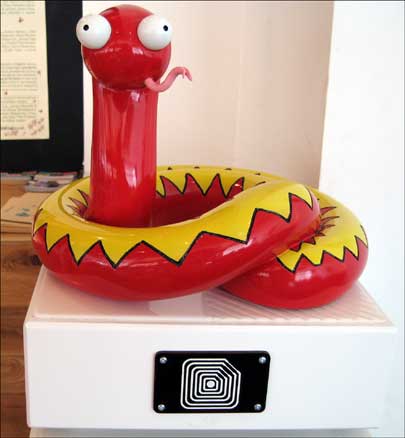A developer of new-media projects has turned to RFID and a game of snakes and ladders to develop an RFID application that could be used to foster interaction between people.
“We wanted to use RFID as a media technology that can be used beyond the warehouse door and can be used for fun,” says Andrew Wilson, codirector of Blink Media, the Huddersfield, England, developer ofRFID Snakes and Ladders.
At The Media Centre, an office building in Huddersfield, the game is being played from May 8 to June 2. The center’s tenants consist of 120 small businesses, each comprised of just one or two employees. According to Wilson, these companies can benefit from the increased networking and interaction the game can inspire.
The RFID-powered game provides such interaction by bringing people together into the common areas of the center. After the game concludes, Blink Media plans to survey the game participants to discover how aware players were of the inclusion of RFID technology, as well as their perception of the technology, both before and after the game.
Later this year, the game will be installed in Antwerp, Belgium. Although a final location has yet to be determined, the site might be a hospital, where it could serve to motivate injured children to move around the building, or perhaps a home for the elderly, to drive social interaction.
At The Media Centre, office workers register their own names and those of their company whenever they join a game. Each player to join a game is given an RFID tag the size of a key fob. Every tag has a unique ID number, used to track a participant’s progress. A maximum of 30 people can play the game at any one time.
RFID Snakes and Ladders’ playing board and rules resemble those of the traditional board game, but instead of rolling a real dice for each turn, players wave their RFID tag in front of an interrogator below a large sculpture of a red die, located in the center’s ground-floor communal area.
The players consult a video monitor to see what number they “rolled” on the virtual dice; they can roll the dice once every three hours. The video monitor shows contestants where they landed, and the same image can be seen on the game’s Web site. If players land on a square with a ladder, then to advance their position on the game board, they must have their tag read by the RFID interrogator installed beneath the sculpture of a yellow ladder on the floor above within the next three hours.
However, any players who land on a square with the head of a snake must visit the sculpture of a yellow-and-red snake, located in the ground-floor café, and have their tags read by the snake’s interrogator. Failure to do so within three hours means sliding down the snake to a previous square on the game board.
Prizes include a sandwich for the first contestant to reach the end of the game, as well as cups of tea for landing on special squares during the game. The prizes have to be collected in the café.
Once a winner emerges, a new game begins. So far, 26 players have signed up to play. The RFID tags contain EM Microelectronic‘s EM 4102 125 kHz chips, with 64 bits of read-only memory.
Players can also view their game progress via a dedicated Web site, which lets them choose a player name. The RFID reader hardware was designed and built by Daniel Blackburn of Carbon Based Games, while game programming and interactivity design were done by Stefan Kölgen and Tony De Telder of Antwerp-based C.H.I.P.S. vzw. The University of Huddersfield provided funding to develop the project.


